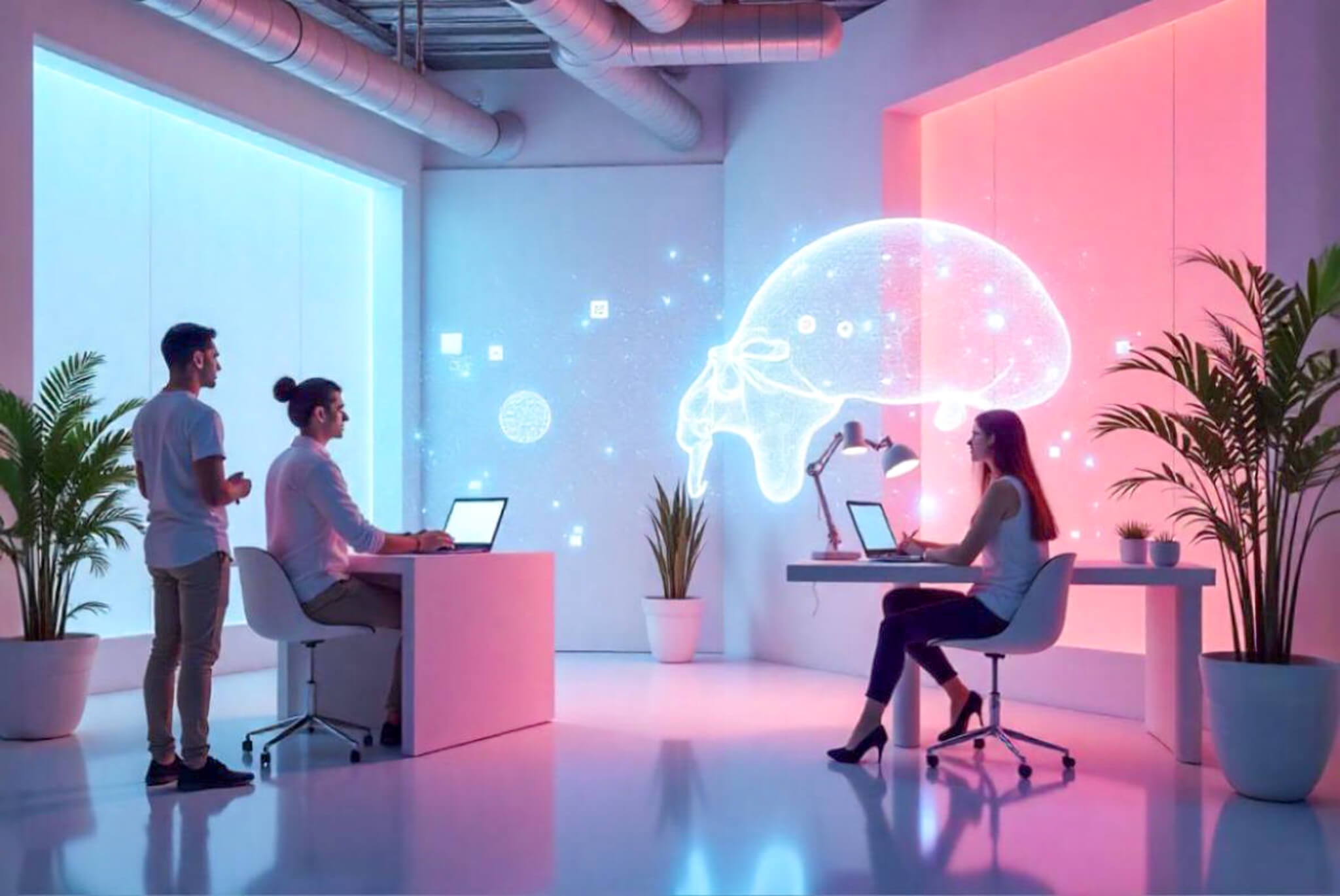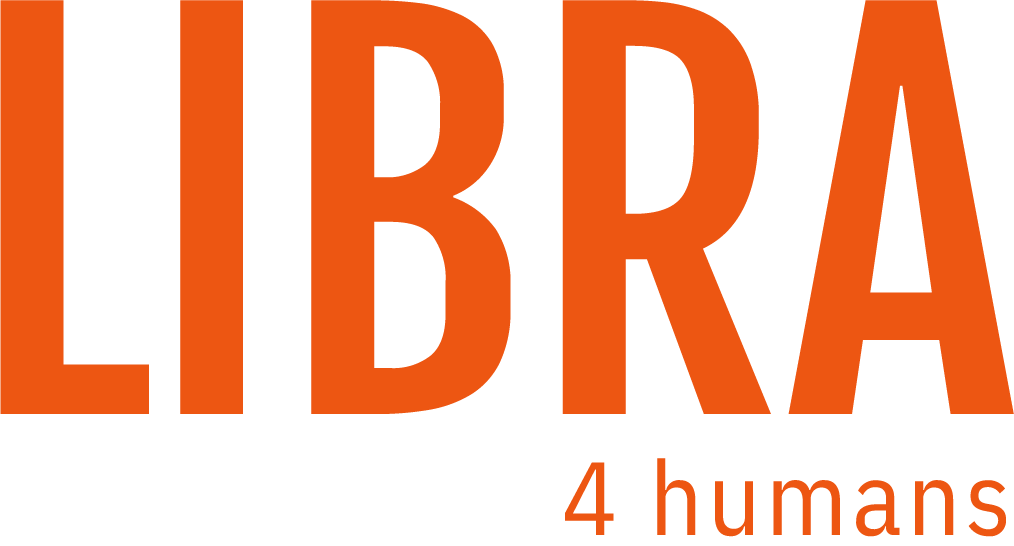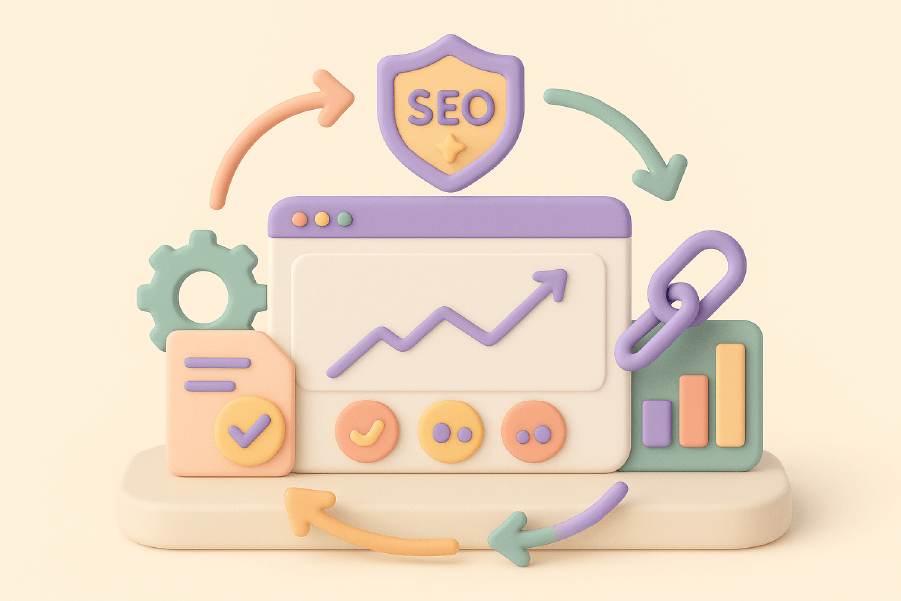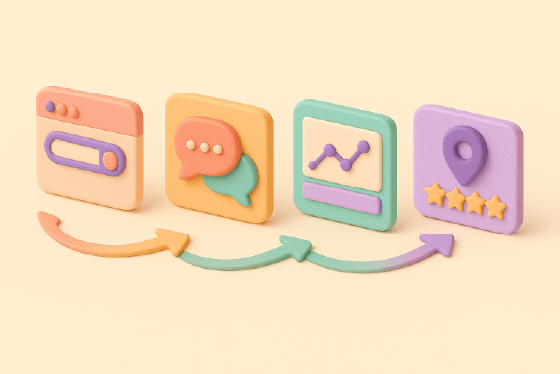Generative AI creates new content like text, images, audio, and videos from data patterns. This technology is revolutionizing content creation, making it easier and faster. In this article, we’ll explore the top generative AI tools for 2025 and how they can transform your creative processes.
Key Takeaways

Generative AI enables the creation of diverse content types, including text, images, audio, and video, enhancing creative capabilities across industries.

Key advancements, such as GANs and the GPT series, have significantly improved the realism and contextual understanding of AI-generated content.

Despite its benefits, generative AI poses ethical challenges, including bias, misinformation, and data privacy concerns that require careful management.
Understanding Generative AI

Generative AI is a groundbreaking technology that creates content, including text, images, audio, and videos, on demand. Unlike traditional machine learning models that primarily focus on classification and prediction, generative AI models can produce entirely new data based on patterns learned from vast datasets. This ability to generate content sets generative AI apart, making it a versatile tool in the creative industry.
At the core of generative AI are neural networks, which mimic the structure of the human brain to recognize patterns and make decisions. These networks are essential for the functionality of generative AI, enabling it to produce high-quality and contextually relevant content. Building such sophisticated models requires significant resources, including billions in funding, advanced talent, and vast amounts of training data.
The power of generative AI lies in its flexibility and adaptability. Whether you need AI-generated images for a marketing campaign or text generation for a blog post, generative AI tools offer a wide range of applications. As we delve deeper, we’ll explore how these tools have evolved and the features that make them indispensable in modern content creation.
The Evolution of Generative AI Models
The journey of generative AI began in the late 1950s with the advent of machine learning, introducing algorithms designed to produce new data. Early models, such as Markov Chains, laid the foundation but were limited in their capabilities. The 1990s marked a significant leap with the introduction of neural networks, which allowed models to learn from data in more sophisticated ways.
A pivotal moment in the evolution of generative AI was the development of Generative Adversarial Networks (GANs) in 2014. GANs consist of two neural networks competing against each other to generate new data, resulting in highly realistic outputs. This innovation opened new possibilities for creating AI-generated content, from images to videos.
Subsequent advancements included the introduction of models like WaveNet for audio generation and the GPT series for text generation. OpenAI’s GPT-2 and GPT-3 models, launched in 2019 and 2020 respectively, showcased the potential for generating coherent text and understanding context. The release of GPT-4 in 2023 further elevated the performance standards of generative AI, enhancing reasoning abilities and contextual understanding.
Visual content generation also saw significant strides with the development of Progressive GANs in 2017, allowing for the creation of high-resolution images. DALL-E, introduced in 2022, demonstrated a blend of language and visual creativity by generating images from descriptive text, marking another milestone in the evolution of generative AI. These developments have collectively transformed generative AI into a powerful tool for creative professionals.
Key Features of Generative AI Tools
Generative AI tools are equipped with a variety of features that significantly enhance creative capabilities. These tools can produce diverse outputs, including text, images, audio, and video, making them versatile assets in content creation. The quality of output is paramount, as effective generative AI tools must produce highly realistic and informative content to meet the demands of users.
User-friendliness is another crucial feature, ensuring that even non-technical users can navigate and utilize these tools effectively. This democratization of access to advanced technology allows a broader range of individuals to benefit from AI-driven content creation. Customization options further enhance the user experience, enabling users to refine AI-generated outputs to match their specific needs and creative visions.
The functionality of generative AI tools is underpinned by complex algorithms trained on extensive datasets. These algorithms enable the tools to identify patterns and generate high-quality content, contributing to the widespread adoption of AI in various creative industries. From text generation to image generators, these powerful tools are revolutionizing how we create and consume content.
Generative AI tools transform the creative process by enabling quick and efficient content production. Whether you’re producing AI-generated images for a campaign or creating AI-generated videos for social media, these tools offer unparalleled flexibility and innovation.
How Generative AI is Revolutionizing Content Creation

Generative AI is changing the landscape of content creation across various media types. Text generation models like OpenAI’s GPT-4 can produce human-like text, adapting styles and responding to prompts with remarkable coherence. This capability is essential for creating personalized content that engages audiences on a deeper level.
In the realm of visual content, AI models like DALL-E are revolutionizing image generation by creating visuals from textual descriptions. This blend of language and visual creativity opens new avenues for producing unique and captivating content. Automated video content creation is another significant development, with AI-driven platforms generating clips from prompts, streamlining the production process and saving time.
The impact of generative AI extends to audio production as well, where AI can synthesize realistic human voices for various media formats. This technology enhances the production of podcasts, audiobooks, and other audio content, making it more accessible and engaging. The global AI market in media and entertainment is projected to expand significantly, reflecting the increasing adoption of AI in content creation activities.
However, the use of generative AI is not without challenges. Issues related to copyright and bias in AI-generated content are significant concerns that require careful ethical considerations. Despite these challenges, the potential for generative AI to transform content creation is immense, offering innovative solutions and enhancing the creative process.
Top AI Tools for Social Media Marketing
In the dynamic world of social media marketing, AI tools are proving to be invaluable assets. These tools optimize content for search engines, ensuring effective keyword integration for improved visibility. They assist in content creation by:
Inspiring social media posts ideas
Automating content generation
Writing text
Recommending hashtags
This makes the process smoother and quicker.
One popular AI tool for social media marketing is Buffer’s AI Assistant, which helps overcome creativity fatigue by speeding up content creation tools. Automated text generation tools, like those provided by Buffer, save time and enhance engagement by generating captions, headlines, and other text-based content. FeedHive excels at content recycling and conditional posting, utilizing AI to enhance engagement on social media channels.
AI-generated videos are another game changer in social media marketing, catering to platform-specific requirements and enhancing user engagement. Tools like Kapwing’s AI Meme Generator allow users to create memes effortlessly, tapping into popular trends and increasing reach. Personalization is a key advantage of AI video tools, allowing marketers to tailor content to individual viewer preferences.
Real-world examples of successful AI-driven campaigns include Starbucks’ personalized rewards and Cadbury’s personalized birthday songs, both of which significantly increased customer engagement. These examples highlight the potential of AI tools to create impactful and engaging social media campaigns.
AI-Generated Videos: A Game Changer for Marketers

AI-generated videos are revolutionizing the way marketers create and distribute video content. The ability of AI tools to quickly generate entire videos from scripts, storyboards, and voiceovers drastically reduces production times. This efficiency allows marketers to produce video content at scale, meeting the demands of a fast-paced market.
The benefits of AI-generated videos extend beyond speed. These tools can significantly improve ROI by increasing conversion rates compared to traditional video production methods. By producing high-quality, engaging videos tailored to specific target audiences, AI tools enhance the effectiveness of video marketing campaigns.
AI video marketing also offers the advantage of personalization, allowing marketers to tailor content to individual viewer preferences. This level of customization enhances user engagement and ensures that the content resonates with the audience. As AI adoption continues to grow, the ability to create AI-generated videos will become an essential skill for marketing teams.
The use of AI in video content creation is a clear indication that marketers are on the right track. By leveraging the power of AI, they can save time, reduce costs, and produce high-quality videos that drive results. The future of video marketing is undoubtedly intertwined with the advancements in AI technology.
Real-World Applications of Generative AI in Branding and Design

Generative AI is making waves in branding and design, offering innovative solutions that enhance brand consistency and creativity. One notable example is Nutella, which used AI to create 7 million unique jar labels, demonstrating the technology’s effectiveness in product differentiation. This approach not only captivated consumers but also reinforced Nutella’s brand identity.
Virgin Voyages took a novel approach by launching ‘Jen AI,’ featuring Jennifer Lopez’s likeness to promote its cruise offerings. This campaign showcased how AI can be used to create personalized and engaging marketing content. Similarly, Coca-Cola partnered with OpenAI to launch the ‘Masterpiece’ campaign, blending art and live-action for a unique and captivating experience.
Heinz employed OpenAI’s DALL-E 2 to generate unique ketchup-themed visuals that celebrated its brand identity, while Nike’s ‘Never Done Evolving’ campaign utilized AI to recreate matches between Serena Williams’ past and present selves. These campaigns highlight the potential of AI to create custom content that maintains a consistent brand voice while resonating with audiences.
BMW’s collaboration with technologist Nathan Shipley to create ‘The Ultimate AI Masterpiece’ campaign using Nvidia’s StyleGAN software is another fascinating example. These real-world applications demonstrate the versatility and power of generative AI in enhancing branding and design, offering new ways to engage and captivate audiences.
Ethical Concerns and Challenges in Generative AI
As generative AI continues to evolve, it brings with it a host of ethical concerns and challenges. One major issue is the potential amplification of existing biases found in the training data, which can affect the outputs produced. This bias can lead to unfair or inaccurate representations, necessitating careful consideration and mitigation strategies.
Another significant challenge is the phenomenon of AI hallucinations, where generative AI models produce content that seems plausible but is factually incorrect. This can be particularly problematic in contexts where accuracy is crucial. Additionally, the use of generative AI may expose companies to legal risks, especially if the content generated is based on unverified or copyrighted data.
Data privacy is another critical concern, as generative AI systems can inadvertently leak personal identifiable information due to the nature of their training data. Mitigation strategies for these risks include careful data selection, using specialized models, human oversight, and avoiding the use of AI for critical decision-making processes.
Ethical considerations such as transparency and bias reduction will become increasingly important as generative AI continues to advance. Ensuring responsible and ethical use of AI will be crucial in maintaining public trust and maximizing the benefits of this powerful technology.
The Future of Generative AI in Creative Work

Looking ahead, generative AI is poised to lead the content creation sector, enabling the automation of various tasks like blog writing and video scripting. By 2025, the media and entertainment industries are likely to fully embrace generative AI, potentially creating entirely AI-driven films and interactive experiences.
The rapid deployment of generative AI tools will lead to significant changes in workforce dynamics and job roles. As AI takes over repetitive tasks, creative professionals will be able to focus more on innovation and strategy, enhancing the overall creative process. However, the environmental impact of large AI models, particularly their carbon footprint, raises concerns about sustainability.
Generative AI tools are anticipated to enhance collaboration between humans and machines, allowing creative professionals to innovate faster and more efficiently. This collaboration will drive the next frontier of creative expression, pushing the boundaries of what is possible in artificial intelligence content creation.
The future of generative AI in creative work is not just about automation; it’s about unlocking new levels of creativity and collaboration. As we move forward, the integration of AI in creative processes will continue to shape the global economy, offering exciting opportunities for innovation and growth.
Summary
Generative AI is undeniably transforming the landscape of content creation, offering tools that enhance efficiency, creativity, and engagement across various media. From the evolution of generative AI models to the practical applications in branding and design, this technology is revolutionizing how we produce and consume content. The advancements in AI-generated text, images, and videos are just the beginning, with the future promising even more innovative and impactful developments.
As we look ahead, the ethical concerns and challenges associated with generative AI must be carefully managed to ensure responsible use. By embracing these technologies while maintaining a focus on ethical considerations, we can harness the full potential of generative AI to drive creative work forward. The journey of generative AI is just beginning, and the possibilities it offers are limitless.
Frequently Asked Questions
What is generative AI?
Generative AI is a transformative technology that generates new content—such as text, images, audio, and videos—by learning from extensive datasets. It stands out from traditional models by its ability to create entirely new data rather than simply analyzing existing information.
How does generative AI differ from traditional machine learning?
Generative AI stands out from traditional machine learning by not just classifying or predicting data, but by also creating new content and outputs based on learned patterns. This capability of generating novel information is a key distinction between the two approaches.
What are some key features of generative AI tools?
Generative AI tools excel in producing diverse outputs such as text, images, and audio, while also being user-friendly and customizable for high-quality results. These features make them versatile and accessible for various applications.
How is generative AI being used in social media marketing?
Generative AI plays a crucial role in social media marketing by optimizing content for search engines, inspiring post ideas, automating content creation, writing text, recommending hashtags, and generating engaging visuals and videos. This technology enhances efficiency and creativity in reaching and engaging audiences effectively.
What ethical concerns are associated with generative AI?
Generative AI raises significant ethical concerns such as bias amplification, the risk of producing incorrect information, data privacy violations, and the generation of unverified content. Addressing these issues requires careful data curation, human oversight, and a commitment to transparency.






